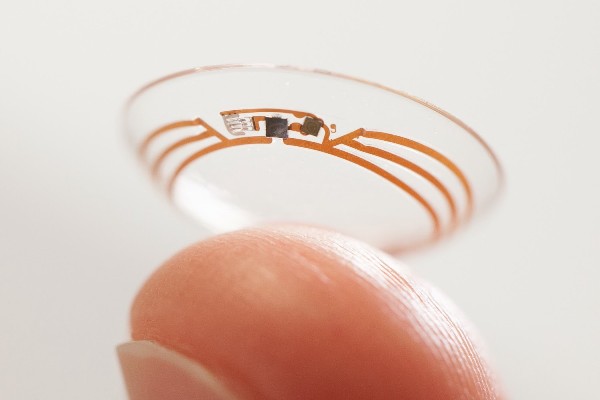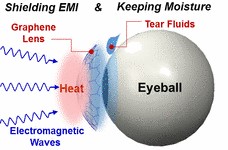ARTICLE – Several years ago (2014), I read an article on Dezeen about how smart contact lenses coated with graphene would allow the wearer to see heat signatures in the dark (using the infrared spectrum). University of Michigan researchers had been working with graphene (a single atom layer of carbon atoms), which is an electrical conductor, to make this possible.
According to the University of Michigan, graphene can detect ultraviolet, visible, and infrared (IR) spectra of light but “it can’t capture enough light to generate a detectable electrical signal” when it comes to the IR spectrum. Zhaohui Zhong, an assistant professor of electrical engineering and computer science, states, “With a one-atom thickness, it only absorbs about 2.3 percent of the light that hits it. If the light can’t produce an electrical signal, graphene can’t be used as a sensor.”
Those researchers found a way to amplify the signal. “Rather than trying to directly measure the electrons that are freed when light hits the graphene, they amplified the signal by looking instead at how the light-induced electrical charges in the graphene affect a nearby current.” And because of this pioneering way of detecting light, they can use graphene in night vision smart contact lenses. This is a vast improvement over current night vision goggles which required bulky cooling tech for the mid and far-infrared sensors.
There was even some research stating that graphene-coated contact lenses could protect the eye (as shown above) from dehydration and electromagnetic (EM) waves that can cause eye problems like cataracts (according to an American Chemical Society publication, “Smart Contact Lenses with Graphene Coating for Electromagnetic Interference Shielding and Dehydration Protection”).
How did this team of researchers test this? They used the graphene-coated contact lenses and placed them on egg whites and subjected them to microwave radiation. The results showed that the “…EM energy is absorbed by graphene and dissipated in the form of thermal radiation so that the damage on the egg whites can be minimized”. They also found that the graphene-coated contact lenses help to prevent dehydration.
Next, in 2017, I read about smart contact lenses which would allow the wearer to record images by blinking (Curiosity article, the above video comes from ScoopWhoop News). Sony, Google, and Samsung are working on this. While wearing a Sony contact lens (you only need to wear one), the electronics can tell the difference between your natural blinking and your controlled blinking which is meant to trigger the capture of an image or start the recording of a video.
These lenses would work independently of any other devices (it would not require you to have your phone with you). All photos and videos would be stored on the lens. Such electrically conductive sensors need batteries to run them and in April 2019, an optical research team at IMT Atlantique in France, lead by Professor Jean-Louis de Bougrenet de la Tocnaye, developed a contact lens with a battery according to New Atlas.
Additionally, in 2017, I read an article about how researchers from Oregon State University were working on developing smart contact lenses that could use your eye’s teardrops to test for your glucose levels using a transparent biosensor made from indium gallium zinc oxide (IGZO). According to Gizmodo, the research team from Oregon State University lead by Gregory Herman stated that the biosensors would contain IGZO transistors as well as an enzyme called glucose oxidase.
When this biosensor comes into contact with glucose, the enzyme oxidizes the blood sugar. This causes the pH level in the mixture to shift, triggering measurable changes in the electrical current flowing through the IGZO transistors. Tiny nanostructures were embedded within the IGZO biosensor, allowing the transparent device to detect minute glucose concentrations found in tears.
According to the article, a lot of information can be gleaned from a teardrop using multiple sensors (2500 biosensors can fit on a one-millimeter square area of the IGZO contact lens). You could potentially detect – “…glucose, but also lactate (sepsis, liver disease), dopamine (glaucoma), urea (renal function), and proteins (cancers)”.
Google had also been working on a smart contact lens that could detect glucose levels over the last several years, but researchers were using different technologies (Gizmodo, 2014).
Furthermore, there are those researchers who are working on smart contact lenses that will potentially give us superhuman eyesight (Curiosity, 2015) and be used for augmented reality (New Atlas, 2019).
All these smart contact lens technologies have been in the works for several years and look like they may need several more years of development and testing before they are available to the public. What do you think – are these the next big wearables of the future? Would you be interested in purchasing any of them? Leave a comment and let me know!






Gadgeteer Comment Policy - Please read before commenting
I’ve been wearing contact lens’s for almost 50 years. I could probably insert a penny in my eye if it had a bit of curve to it. I am so ready for augmented vision, particularly since I had cataract surgery a few years ago.
Where do I sign up?
Craig C Oconnor – I hear you! I would love to have better vision too that is protected from EM waves. I wore contact lenses for about 10 – 15 years and then got lazy about putting them in so now I wear glasses.
I’m a little wary of the camera contact lenses, but all of the other technologies seem pretty promising. I’m looking forward to seeing which ones go to market. I’ll update this post when that happens.
Im so waiting for this to happen… !!
I’ve been exploring smart contact lenses for last two years, and it seems like there’s too much big comanies workig on developing this, each one in it’s own way and for a different main purpose.. and i think that maybe this is the reason why it tooks so much time to develop and still there’s no even first product in the markets…
Anyway.. i have to summarize my article this month..
If you have any sources of information about SMART CONTACT LENSES PREDICTION please let me know 🙂
Perfect Issues – I do not have any information about or sources indicating when we might start seeing smart contact lens products.
Smart contact lenses are the future as they can help a lot to solve the current problems with contact lenses. You have shared a very informative article with us. I gained a lot of knowledge about the future of contact lenses from your article. Thank you for sharing this informative article with us.